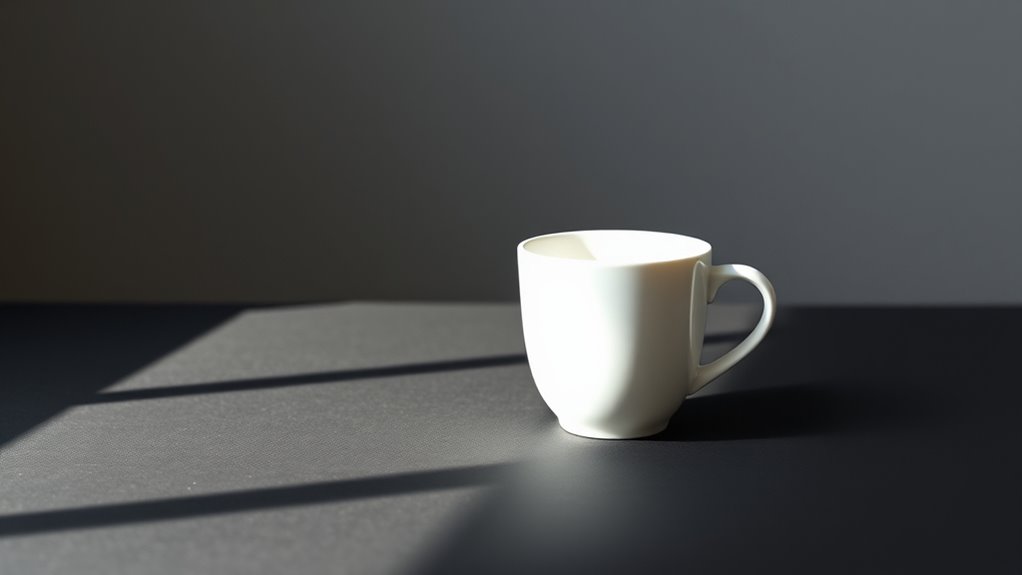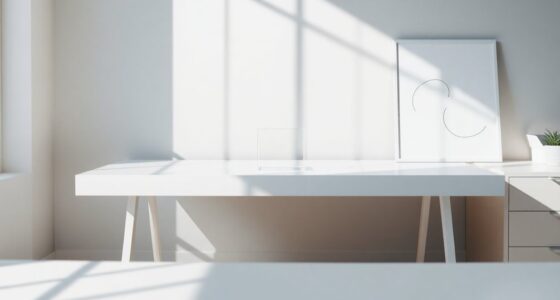Discover the beauty of simplicity in minimalist photography by focusing on bold shapes, clean lines, and ample negative space. Use limited colors and simple compositions to highlight your main subject and create visual impact. Playing with light and contrast can add depth and emotion, while thoughtful framing keeps distractions away. Embracing these principles helps you craft powerful, calm images that tell a story with less. Keep exploring to uncover the full potential of minimalist art.
Key Takeaways
- Minimalist photography emphasizes simplicity by focusing on a few impactful elements, creating strong visual messages.
- Effective use of negative space draws attention to the main subject and adds depth to the composition.
- Limiting color palettes enhances harmony, guides viewer focus, and reinforces the minimalist aesthetic.
- Thoughtful framing and composition isolate key elements, eliminating distractions and emphasizing clarity.
- Strategic use of light, contrast, and texture heightens visual impact and conveys emotion through simplicity.
The Principles Behind Minimalist Photography
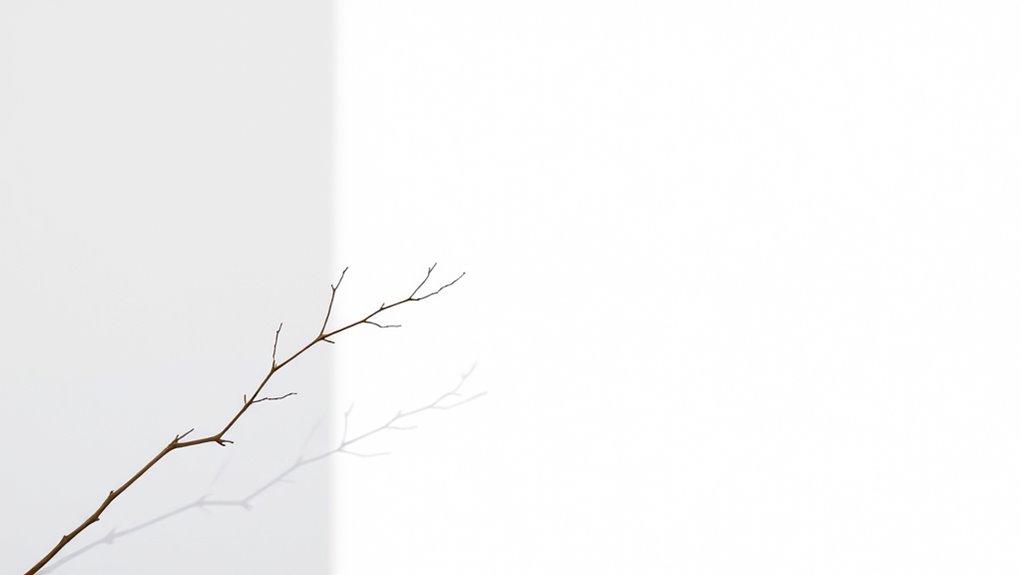
Minimalist photography is built on the idea that less is more. To master it, you focus on creating a strong visual impact with minimal elements. Color harmony plays a crucial role—you choose a limited palette to evoke mood and unify your composition. Vibrant or subdued, your color choices should complement each other, enhancing the simplicity without overwhelming the viewer. Visual balance is equally important; you arrange your subject and negative space carefully to guide the eye naturally across the image. Symmetry, asymmetry, or centered compositions all work if they contribute to a sense of harmony. Developing your skills through consistent practice can help you better understand how to use attention to detail effectively in your compositions, as it allows you to refine elements that contribute to overall visual harmony. Additionally, understanding how relationships between elements influence perception can elevate the impact of your minimalist work and deepen your appreciation for interior design basics, as both fields emphasize the importance of harmony and simplicity.
Choosing the Right Subjects for Minimalist Shots
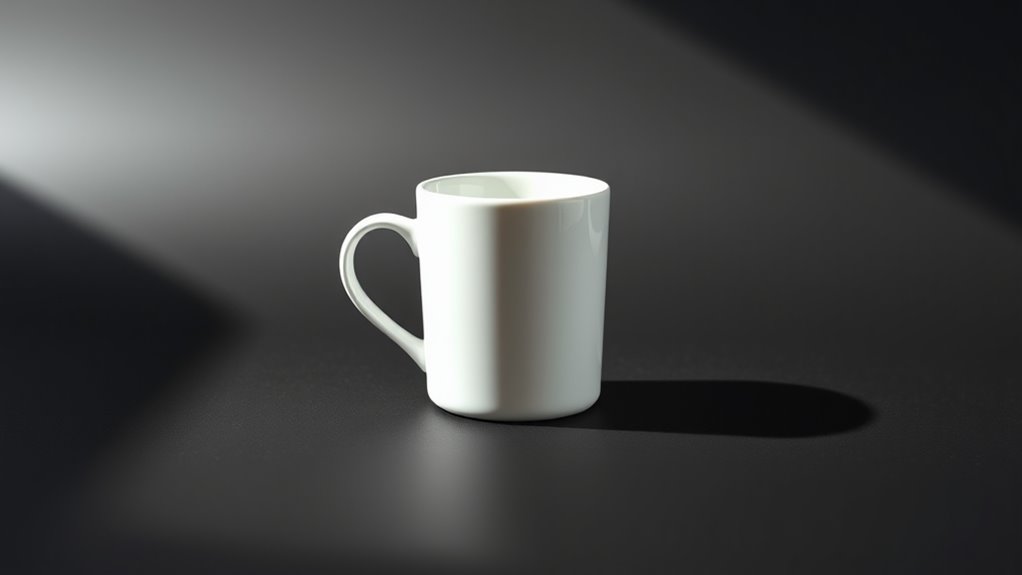
How do you select subjects that truly shine in minimalist photography? Focus on scene simplicity and strong visual impact. Look for subjects with clear lines, shapes, or textures that stand out against a clean background. Minimalist shots thrive on fewer elements, so choose subjects that convey meaning or evoke emotion with minimal distraction. Consider the following table for guidance:
| Criteria | Examples |
|---|---|
| Clear, bold shapes | A single tree, a lone chair |
| Unique textures | Bark, fabric folds |
| Striking contrasts | Light and shadow play |
Prioritize simplicity in your subject selection to create powerful, uncluttered images. Remember, less is more—let your subject speak for itself. Additionally, understanding the WWE Raw’s Financial Impact can inspire you to focus on iconic, visually striking subjects that hold cultural significance. Recognizing how AI enhances visual content can also help in editing and presenting your minimalist images with modern tools. Developing an eye for composition and understanding visual balance will help ensure your compositions are both compelling and harmonious.
Techniques to Enhance Simplicity and Focus
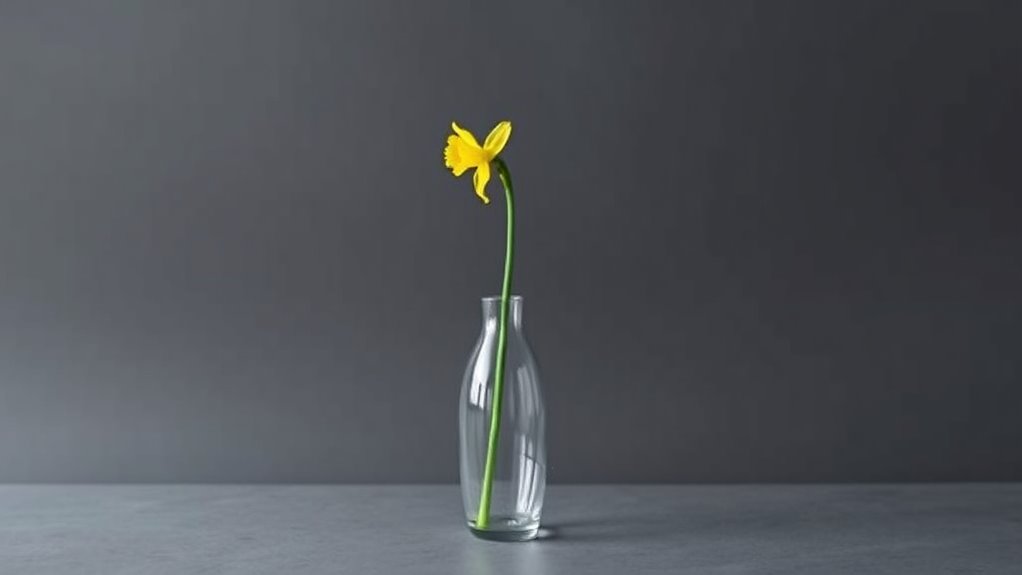
To sharpen the simplicity and focus in your photos, start by using negative space effectively to draw attention to your subject.
Limiting your color palette can also make your image feel more cohesive and uncluttered.
Finally, pay close attention to composition to guarantee every element guides the viewer’s eye and enhances the overall minimalism.
Incorporating visual balance into your frame can further elevate the clean and simple aesthetic of your photographs.
Being mindful of regional resources and local scenery can help you find inspiring backgrounds that complement your minimalist style.
Use Negative Space Effect
Using negative space effectively can dramatically enhance the simplicity and focus of your photographs. It directs viewers’ attention to your subject, creating a sense of balance and clarity. By leaving ample empty space, you emphasize the main element and improve color contrast, making it stand out. Negative space also enhances depth perception, giving your image a three-dimensional feel. To understand this better, consider the table below:
| Element | Effect | Benefit |
|---|---|---|
| Large empty area | Simplifies composition | Focus on subject |
| Minimal details | Reduces visual noise | Clearer message |
| Contrast levels | Highlights main element | Improved color contrast |
| Depth cues | Adds dimensionality | Enhances depth perception |
Additionally, incorporating composition principles can help you create more balanced and impactful images. Use negative space intentionally to make your minimalist photography more impactful. Understanding and applying the Law of Attraction can also help you cultivate a mindset that appreciates and seeks out simplicity and clarity in your creative pursuits. Moreover, paying attention to AI-driven design insights can provide valuable guidance on visual balance and emphasis.
Limit Color Palette
Limiting your color palette is a powerful way to enhance the simplicity and focus of your minimalist photos. When you restrict colors, you create a stronger sense of color harmony, guiding the viewer’s eye and emphasizing your subject. A limited palette reduces visual clutter, allowing key elements to stand out and making your image feel more cohesive. This technique also contributes to better visual balance, ensuring no single color overwhelms the composition. By choosing a few complementary or monochromatic tones, you simplify your scene and direct attention where it matters most. Stick to a restrained color scheme, and you’ll craft images that feel calm, deliberate, and visually compelling. Additionally, understanding the color psychology behind your palette can further enhance the emotional impact of your minimalist photography. Incorporating visual hierarchy principles can help you emphasize focal points and create a more engaging composition. To maintain consistent design harmony, it’s helpful to select colors that complement each other naturally. Using a limited color palette can also make your editing process more straightforward and cohesive. Emphasizing color contrast within your chosen palette can add depth and interest, even with fewer colors. Ultimately, a limited color palette sharpens your minimalist aesthetic and highlights the beauty found in simplicity.
Focus on Composition
Focusing on composition allows you to direct attention and create impactful minimalist images. To achieve this, use framing techniques that isolate your subject and eliminate distractions.
Simple framing, like placing your subject off-center or using natural elements, guides the viewer’s eye and emphasizes clarity. Pay attention to color contrast; bold differences between background and foreground highlight your subject and add visual interest without clutter. Keep the background clean and uncluttered, ensuring the main element stands out.
Experiment with negative space to create balance and draw focus inward. By thoughtfully arranging your scene and leveraging color contrast, you enhance the simplicity of your composition, making your minimalist images more powerful and engaging.
The Role of Composition and Negative Space

The power of composition and negative space lies in their ability to direct your viewer’s attention and create a sense of balance within a photograph. By carefully placing the main subject and surrounding empty areas, you emphasize the subject through effective use of negative space.
Color contrast plays a crucial role here, making your subject stand out against the background. It also enhances depth perception, giving your image a three-dimensional feel that draws the viewer in.
When you utilize negative space thoughtfully, you allow your subject to breathe, avoiding clutter and highlighting simplicity. This balance makes your photo more engaging and impactful, guiding the eye naturally.
Mastering composition and negative space transforms minimalism from a simple style into a powerful storytelling tool.
Using Light and Color to Create Impact
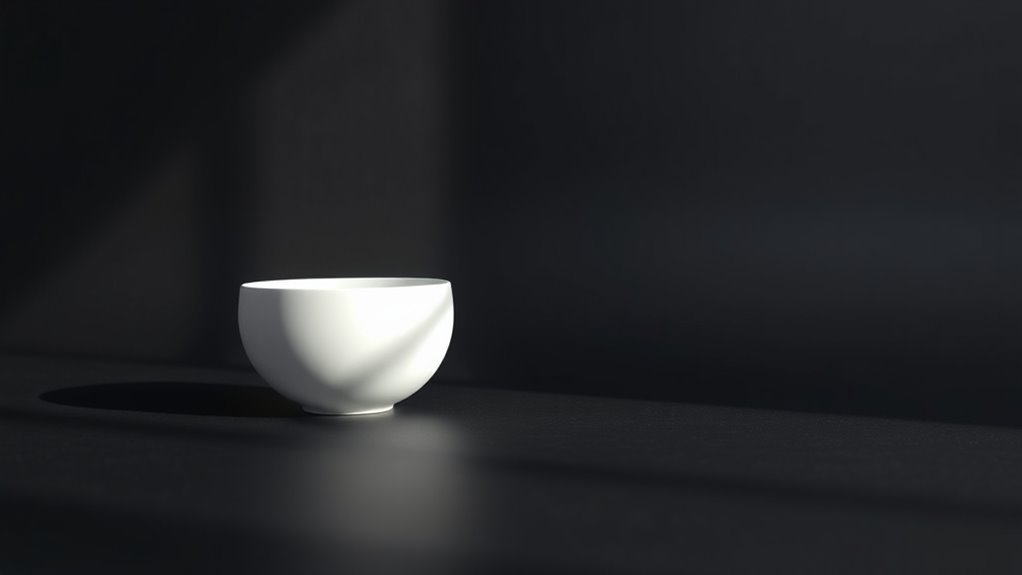
Light and color are powerful tools that can elevate minimalist photographs, transforming simple scenes into striking visual statements. By mastering light manipulation, you can create depth and focus, guiding the viewer’s eye.
Color harmony also plays a key role in establishing mood and cohesion. To maximize impact, consider these tips:
- Use natural light during golden hour for warm, soft tones.
- Experiment with high contrast to emphasize shapes and negative space.
- Limit your color palette to maintain simplicity and harmony.
- Play with shadows and light to add dimension and intrigue.
Inspiring Minimalist Photography Examples
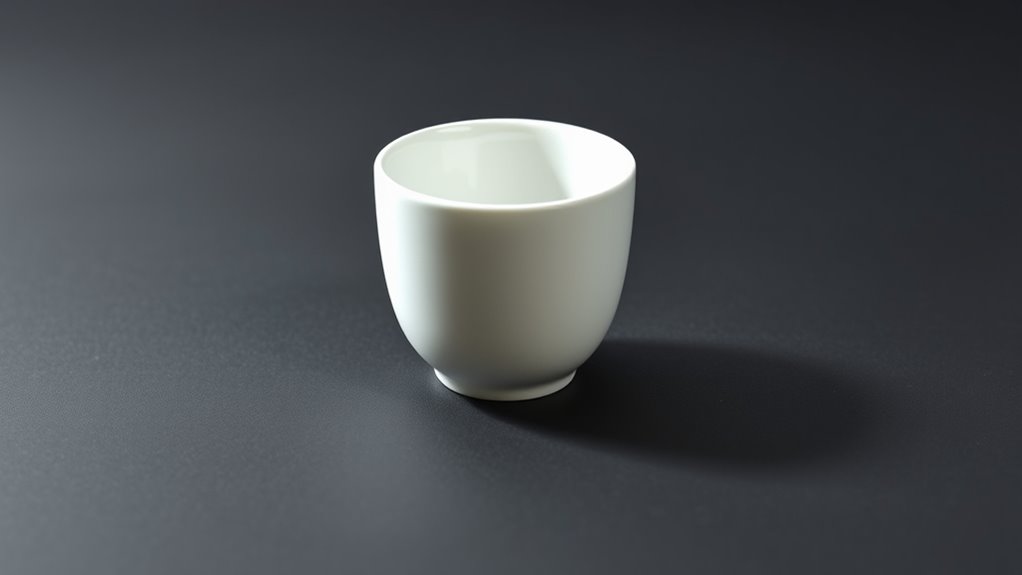
In inspiring minimalist photos, you’ll notice striking composition techniques that draw your eye instantly.
Bold use of negative space often highlights the subject and creates a sense of balance.
These examples show how simplicity can make a powerful visual statement.
Striking Composition Techniques
Striking composition techniques are essential for creating minimalist photographs that captivate viewers. They help you highlight key elements through clear visual storytelling.
To achieve this, consider these approaches:
- Use strong color contrast to draw attention and create visual impact.
- Emphasize texture by focusing on surface details that add depth.
- Apply the rule of thirds to position your subject dynamically.
- Simplify your background to keep the viewer’s focus on your main subject.
Bold Use of Negative Space
Harnessing negative space boldly can transform your minimalist photos into powerful visual statements. By intentionally leaving large areas of empty space, you create a striking contrast that draws attention to your subject.
This approach enhances visual balance, making the focal point stand out more vividly. The negative space also amplifies emotional impact, allowing viewers to feel a sense of calm, isolation, or openness.
When used effectively, it guides the viewer’s eye naturally and emphasizes the simplicity of your composition. Remember, negative space isn’t just empty; it’s a deliberate tool to reinforce your message.
Embrace this technique to craft images that are both aesthetically compelling and emotionally resonant, elevating your minimalist photography to new levels of clarity and power.
Frequently Asked Questions
How Can Minimalist Photography Improve My Overall Photographic Skills?
Minimalist photography can considerably improve your skills by sharpening your eye for effective composition techniques. It encourages you to focus on a simple subject, making every element count.
You’ll learn to select a cohesive color palette that enhances the mood and clarity of your images. By practicing minimalism, you develop patience and precision, ultimately elevating your overall photographic style and ability to create striking, impactful photos with less clutter.
What Common Mistakes Should Beginners Avoid in Minimalist Photography?
Like a painter avoiding clutter on a canvas, you should steer clear of common beginner mistakes in minimalist photography. Focus on strong composition tips, such as using negative space effectively.
Master lighting techniques to highlight your subject without distraction. Avoid overcomplicating your shot or adding unnecessary elements.
Keep it simple and intentional, ensuring each component serves a purpose, so your image communicates clearly and powerfully.
Which Camera Settings Are Best Suited for Minimalistic Shots?
For minimalistic shots, you want to keep your camera settings simple. Use a wide aperture to create a shallow depth of field, making your subject stand out and the background blur nicely.
Choose a focal length that emphasizes your main element, often a longer lens for isolating subjects.
Keep ISO low to avoid noise, and set your shutter speed based on the lighting.
These settings help create clean, impactful minimalist images.
How Can I Incorporate Minimalist Principles Into Everyday Photography?
You might think everyday photography is cluttered, but you can incorporate minimalist principles by focusing on negative space and color contrast.
Simplify your scenes by removing unnecessary details and highlighting a single subject. Use negative space to draw attention and create balance.
Embrace a clean background and bold color contrasts to make your subject pop. This approach transforms ordinary shots into striking minimalist images effortlessly.
What Are the Best Editing Techniques for Enhancing Minimalist Images?
To enhance minimalist images, focus on simple editing techniques like color correction to emphasize key tones and contrast enhancement to make your subject stand out.
Keep adjustments subtle to maintain the clean, uncluttered feel. Use tools that allow precise control, avoiding over-editing.
This approach helps your minimalist compositions remain impactful, highlighting their simplicity while making the essential elements more striking and visually appealing.
Conclusion
Embrace simplicity to find beauty in the everyday. Focus on what matters, sharpen your eye for detail, and let negative space breathe life into your images. Simplify your compositions, highlight your subjects, and play with light and color to evoke emotion. With each shot, discover clarity, calm, and connection. Remember, less truly is more—so keep it simple, keep it honest, and let your photography speak volumes with just a few elements.
